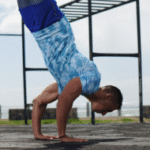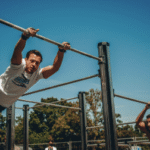How to Find the Best Handstand Class for You: A Houstonian’s Guide
You’ve decided to take on one of the most rewarding challenges in bodyweight fitness: learning to handstand. In a city like Houston, with a thriving and diverse fitness scene, you have plenty of options. But how do you choose the right one? The “best” class isn’t a one-size-fits-all answer; it’s the one that perfectly aligns with your goals, your current abilities, and your learning style.
This guide will provide you with a detailed, step-by-step framework to help you research, vet, and select the handstand class that will give you the best possible chance of success.
Step 1: Self-Assessment – Define What “Best” Means for You
Before you even start searching, you need to know what you’re looking for. A great class for a seasoned yogi might not be the best fit for an absolute beginner.
What Are Your Primary Goals? Be honest with yourself. Are you looking to:
Build a Foundation? Simply get comfortable being upside down and build the foundational strength.
Achieve a Freestanding Hold? Your main goal is to hold a straight, freestanding handstand for a specific duration (e.g., 10 seconds).
Enhance Another Practice? Improve your inversions for yoga, CrossFit, or another discipline.
Have Fun and Get Fit? Learn a new skill in a social and engaging environment.
What is Your Current Level?
Absolute Beginner: You have zero experience and have never kicked up against a wall.
Wall-Proficient: You can hold a handstand against a wall for 30-60 seconds but have no balance away from it.
Some Experience: You can occasionally balance for a few seconds but lack consistency and control.
What is Your Learning Style?
Do you thrive with lots of one-on-one attention and technical feedback?
Do you prefer a structured, methodical curriculum ?
Do you enjoy a playful, exploratory environment ?
Step 2: Research Your Options in Houston
Now that you know what you’re looking for, you can start exploring the different types of places that offer handstand training.
Dedicated Calisthenics & Handstand Studios: These are often your best bet for a comprehensive, skill-focused program. Places like Mekanix Houston or Calisthenics Club Houston offer specific “Hand Balancing” classes. Their entire philosophy is built around bodyweight skill progression.
Yoga Studios with Inversion Workshops: Many Houston yoga studios, such as Black Swan Yoga , offer “inversion workshops” or advanced classes that focus on handstands. The approach here is often more focused on alignment within a yoga context and may be less strength-and-conditioning heavy than a calisthenics gym.
Gymnastics Centers with Adult Programs: Facilities like the Evelyn Rubenstein JCC offer adult gymnastics classes. These are fantastic for learning the absolute fundamentals of body line, strength, and spatial awareness from coaches with a deep understanding of the basics.
Private Coaches: For the most personalized and accelerated path, consider a private coach. A quick search for “Houston Handstands” will reveal specialists who offer one-on-one sessions tailored entirely to your needs. This is the most expensive option but offers the most direct feedback.
Step 3: The Vetting Process – How to Spot a Quality Class
Once you have a shortlist, it’s time to dig deeper. Look for these green flags on their websites, social media, and class descriptions.
The Instructor’s Background: Look for instructors with a legitimate background in gymnastics, circus arts, high-level calisthenics, or advanced yoga. Read their bios. Do they just do handstands, or do they have experience teaching them to beginners?
A Clear Focus on Safety and Fundamentals: This is the most important factor. A quality program will explicitly mention:
Wrist Preparation: A dedicated warm-up to strengthen and mobilize the wrists.
Learning to Fall: Instruction on how to safely “bail out” of a handstand (e.g., cartwheeling out).
Conditioning: A focus on building foundational strength in the shoulders and core before attempting complex skills.
A Structured, Progressive Curriculum: The class description should talk about using the wall as a primary training tool and using step-by-step drills and progressions . Be wary of any class that suggests you’ll be kicking up in the middle of the room on your first day.
Small Class Sizes: For a technical skill like this, individual attention is key. Smaller classes (ideally under 10-12 students per instructor) ensure the coach can provide personal feedback and safe spotting.
Positive and Realistic Reviews: Look for testimonials from people who started as beginners. Do they describe the environment as supportive, safe, and encouraging?
Step 4: The Trial Class – The Ultimate Litmus Test
You can do all the research in the world, but the only way to truly know if a class is right for you is to experience it.
Book a Drop-In or Trial: Most studios in Houston offer a single drop-in class or a new student special. This is a low-commitment way to test the waters.
During the Class, Pay Attention:
The Vibe: Does the environment feel welcoming and non-judgmental? Is it okay to fail?
The Instructor: Do they give individual corrections? Are their instructions clear and easy to understand? Do they prioritize your safety?
The Other Students: Is there a sense of community and mutual support?
Your Gut Feeling: Most importantly, did you have fun? Did you leave feeling challenged but empowered?
Conclusion:
Finding the best handstand class in Houston is a personal journey of matching your individual needs with the right program and instructor. By first understanding your own goals, researching the different types of offerings, vetting them for a focus on safety and fundamentals, and finally, taking a trial class, you can make an informed decision. The right class won’t just teach you how to balance on your hands; it will provide a safe, supportive, and motivating environment that makes the entire challenging process a rewarding and empowering adventure.

How to Find the Best Handstand Class for You: A Houstonian’s Guide
Route
Calisthenics Gym Houston Functional Bodyweight Training
Secondary phone: (346) 483-3195
Email: info@calisthenicsclubhouston.com
URL: https://calisthenicsclubhouston.com/
Monday 6:00 AM - 7:00 PM Tuesday 6:00 AM - 7:00 PM Open now Wednesday 6:00 AM - 7:00 PM Thursday 6:00 AM - 7:00 PM Friday 12:00 PM - 6:30 PM Saturday 9:45 AM - 12:00 PM Sunday 3:00 PM - 5:00 PM





